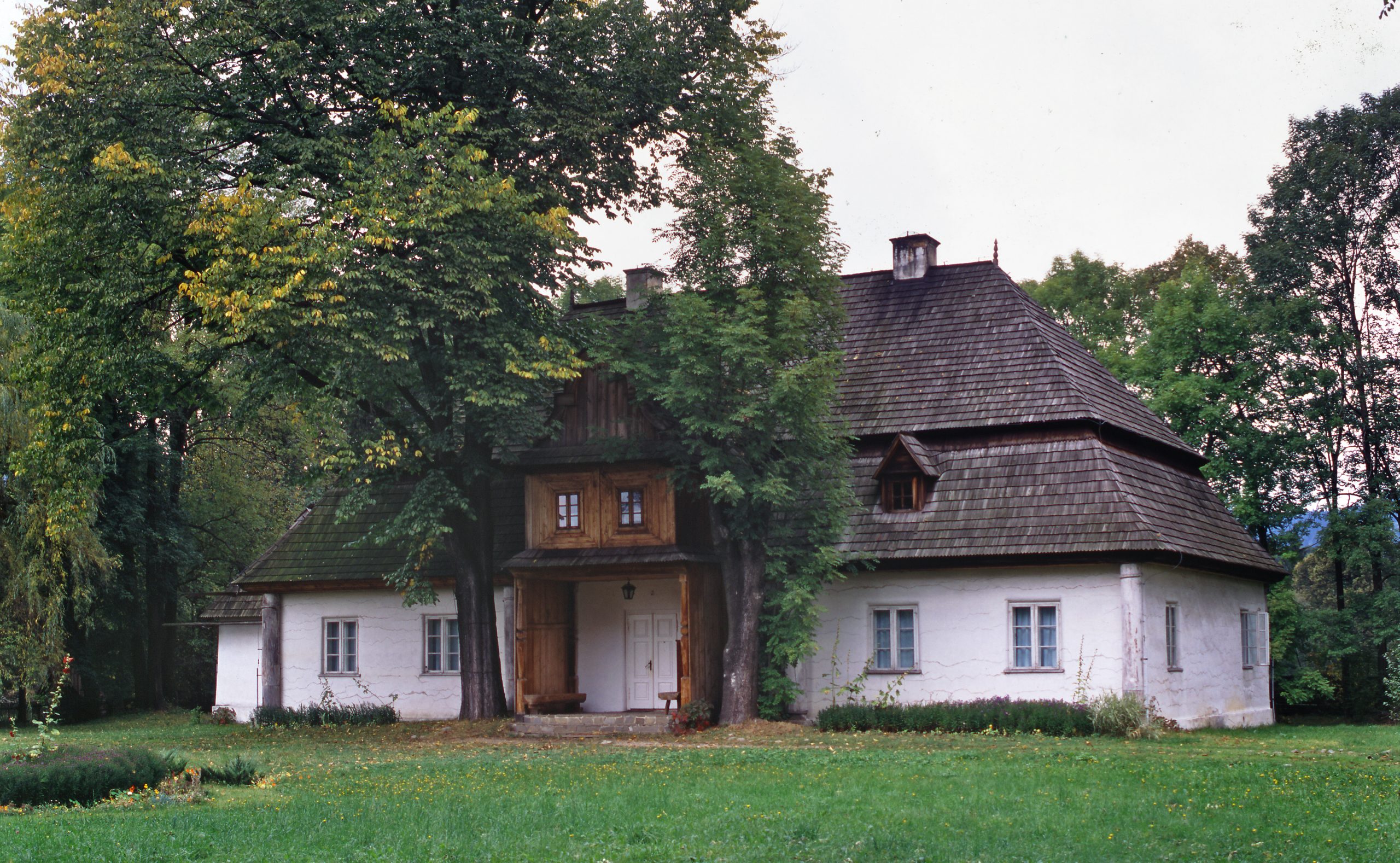Prices:
normal 6,00 zł
reducet 4,50 zł
Guided tours: 30 zł + ticket
Free entry every Sunday
Opening hours:
WED - SUN
10.00 AM - 4.00 PM
MON - TUE - closed
Last entry - 0,5h before closing
Address:
34-432 Łopuszna
+48 18 26 539 19
+48 535 668 777
lopuszna@muzeumtatrzanskie.pl

(branch of the Tatra Museum)
Travelling from Nowy Targ in the direction of Czorsztyn, it is worthwhile visiting the village of Łopuszna, beautifully situated at the foot of the Gorce Mountains and, while in the village, see the manor, formerly the seat of the noble patriotic families of the Lisickis, Tetmajers and Lgockis.
The grange at Łopuszna dates back to the 16th century. The manor was built much later, about 1790, by Romuald Lisicki, a former confederate of Bar. The earliest printed description of the manor features in Dziennik podróży do Tatrów [Records of a Journey to the Tatra Mountains] by Seweryn Goszczyński, published in 1851. The Romantic poet had fought in the November Uprising, was engaged in clandestine patriotic activities and, after the defeat of the uprising, went into hiding in Łopuszna. This is how Goszczyński writes about the manor in 1832: ‘A wooden house in the style of all our native gentry residences: spacious, carefully and solidly built, decorated with a porch that looks like all our porches, with benches at its sides, like those seen everywhere else…. In front of the manor is a spacious courtyard with a smaller house, or an annexe; on the left are the kitchen and servants’ rooms, on the right farm buildings shelter the manor.’
This is also how the manor features in a drawing by the Cracow painter and draughtsman Stanisław Cercha who included it in his unpublished 1891 monograph entitled Łopuszna (wieś w powiecie nowotarskim)… [Łopuszna, a village in the County of Nowy Targ…].
During Goszczyński’s stay at Łopuszna, Leon Przerwa-Tetmajer and his wife Ludwika née Lisicka were the owners of Łopuszna. After Leon’s death in 1881 and Ludwika’s death in 1889, their daughter Kamila inherited the property. She married Kazimierz Lgocki. In 1892, the Lgockis had the manor renovated, after which its appearance changed. The wooden walls were plastered and whitewashed. Round wooden pillars were constructed to relieve the walls by taking upon themselves the weight of the high mansard roof.
Then Kazimierz and Kamila Lgocki’s sons, Aleksander followed by Stanisław, inherited the Łopuszna manor. The estate remained in the hands of members of the Lgocki family between the World Wars, in which period modern farming machines were introduced and the largest sheepfold at the foot of the Tatra Mountains was built. Some of the villagers of Łopuszna still remember the last manor owners as good organizers living on a modest scale. After World War II, the estate shared the fate of many others: taken over by the Treasury and conveyed to a state farm, the manor and the farm buildings were incompetently used, not renovated and gradually fell into disrepair. In May 1978, the manorial complex was taken over by the Tatra Museum and systematic restoration began. A kitchen has been arranged in the manor. There is also an exhibition devoted to the village of Łopuszna, the history of the manor, its inhabitants and guests. Beside the manor, there is a small old house called ‘Gacek’. (Gacek was the pseudonym of another Romantic poet of the ‘Ukrainian school’, Bohdan Zaleski, who lived here.) In the garden we can see the surviving cellars of a cottage where Seweryn Goszczyński was put up. The remaining cottage interiors were used for storing useless objects.
Outside the fence enclosing the manorial buildings, along the way to the village of Łopuszna, there is a wooden cottage transferred here from the village. Dismantled by the owners, it was purchased by the Tatra Museum in 1980. Marked No. 105, the cottage belonged to the Klamerus family with many branches (differing in nicknames) in Łopuszna. It was built in 1887 by Jan Klamerus ‘Sowa’ (the Owl), as evidenced by the inscription on the main beam in the ‘big chamber’.
The furniture in the Klamerus cottage was mostly purchased in the village. The cottage consists of several well-furnished interiors, the vestibule, the kitchen, the ‘big chamber’, and interiors intended for housekeeping functions, the attic and the larder, the latter annexed to the house from the back.
From the vestibule used for the storage of articles of daily use, such as kitchen utensils and small household and farming implements, we enter the kitchen. It is modestly furnished with the bench by the stove used for putting kitchen vessels on and the wooden rod spanned between the stove and the opposite wall used for hanging clothes. Tableware and smaller kitchen utensils were kept in a small open cupboard called the shelf. As in many homes, we can see kitchen utensils manufactured in different periods. Those made of wood, clay and cast iron are the earliest ones, followed by mass-produced enamelled metal pots and pans, and earthenware articles.
As indicated by the name, the ‘big chamber’, a representational interior, is much larger than the kitchen. The characteristic construction element here is a huge beam beneath the ceiling, the main beam, in the middle of which are carved stars (rosettes) and inscriptions, usually with the name of the carpenter and the date of the completion of the building. The table was always an important place in the chamber. Here the family had meals on feast-days, and here the more important guests were seated. Besides the furniture including a bed, a cradle, and a box for storing clothes, the ‘big chamber’ contains, running between the walls, a decorative shelf with a balustrade, with religious pictures hanging on the shelf in a row and decorative pottery beneath. As in the ‘black’ chamber, a special rod was used for hanging clothes instead of a wardrobe.


